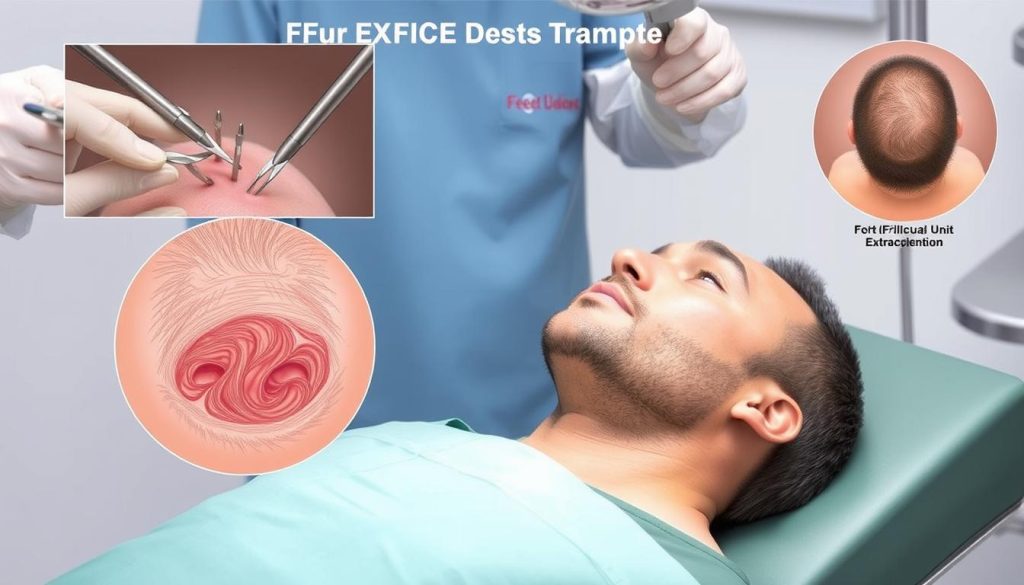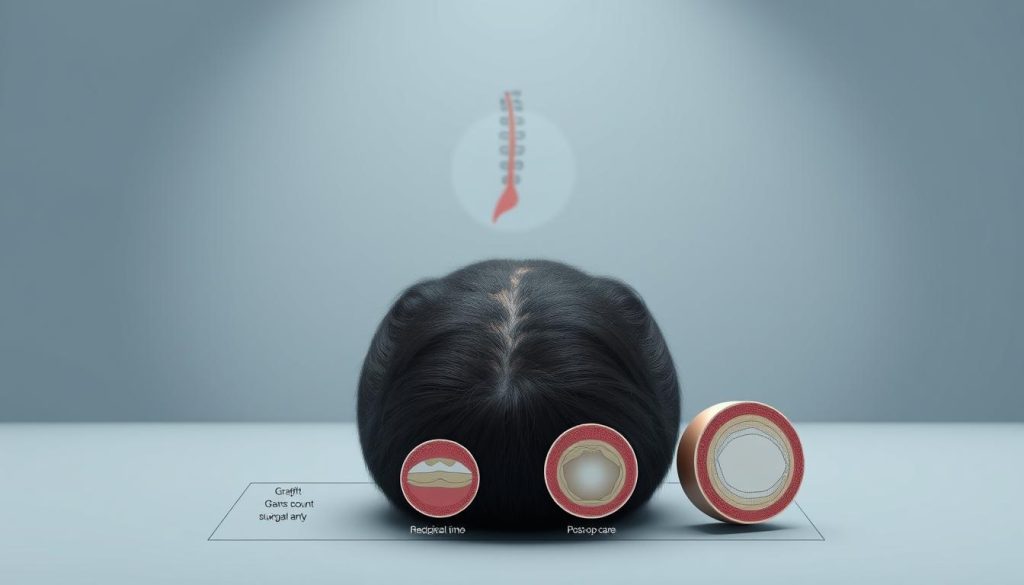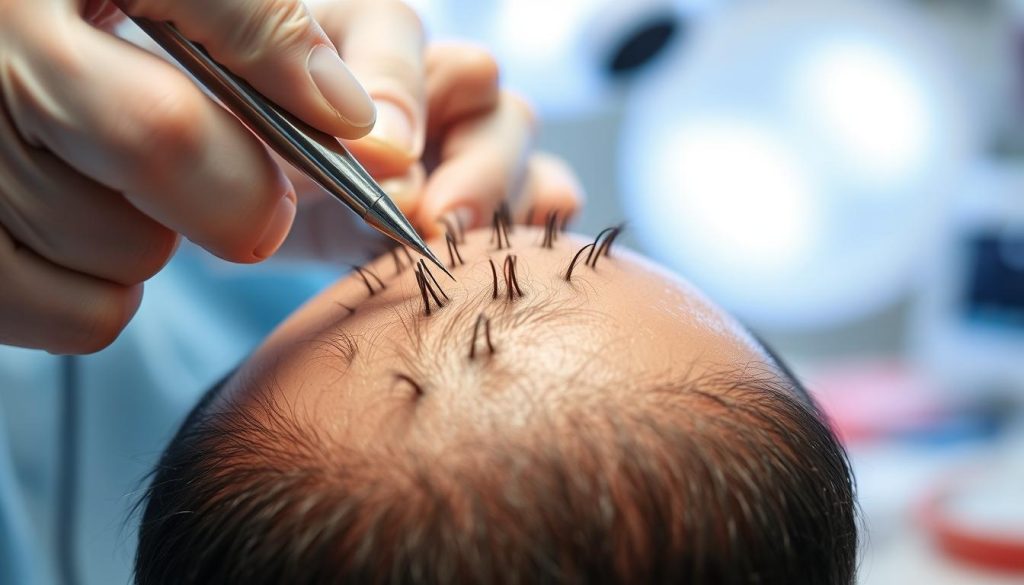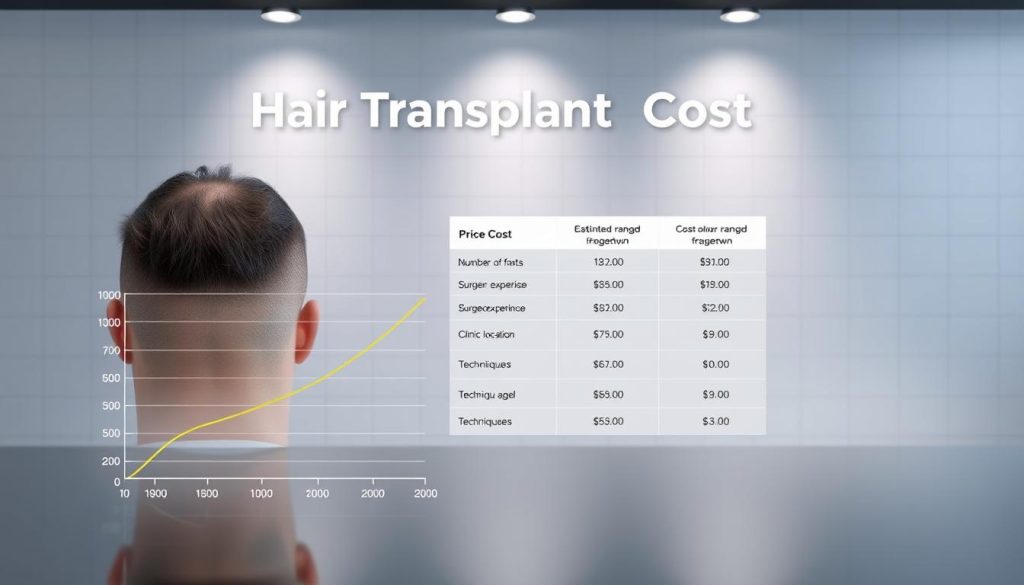For individuals considering hair restoration, understanding the costs involved is crucial. The average cost of a hair transplant procedure can range from $8,000 to $15,000, with some clinics averaging between $6,000 to $12,000.
The cost varies widely based on factors such as the extent of hair loss, the procedure type, and the surgeon’s experience. This comprehensive guide will explore these factors, providing patients with the information needed to make informed decisions about their hair restoration journey.
Key Takeaways
- The average cost of a hair transplant procedure ranges from $8,000 to $15,000.
- Factors influencing the final cost include procedure type, extent of hair loss, and surgeon experience.
- Clinics may use per-graft pricing or comprehensive package pricing.
- Financing options and insurance considerations can impact the overall cost.
- Evaluating the true value of a hair transplant involves considering the quality of the procedure.
- Patients should research to find a balance between cost and quality for long-lasting results.
Understanding Hair Transplant Costs
Understanding the costs associated with hair transplants requires insight into several key factors. The art of hair restoration surgery depends on the artistic hairline design by the surgeon, meticulous harvest and placement techniques employed by experienced hair technicians, and adherence to postoperative care instructions.
Average Price Range in the United States
The average cost of hair transplantation in the United States varies widely. Several factors contribute to the overall cost, including the clinic’s reputation and the experience of the surgeon.
Why Costs Vary Between Clinics
Several factors influence the variation in costs between clinics:
- Clinic reputation and surgeon experience significantly impact pricing.
- The technology and techniques employed, such as follicular unit extraction, influence costs.
- Staff expertise and overhead costs also play crucial roles.
How Much is Hair Transplant: Breaking Down the Numbers
Breaking down the numbers is crucial to understanding hair transplant costs. The total cost of a hair transplant procedure is influenced by several factors, including the technique used, the number of grafts required, and the clinic’s pricing model.
Typical Cost Range: $6,000-$15,000
The average cost for a hair transplant in the United States ranges from $6,000 to $15,000. This comprehensive pricing typically includes the procedure, post-operative care, and sometimes follow-up appointments.
Per Graft Pricing vs. Comprehensive Pricing
Clinics often use either per-graft pricing or comprehensive pricing models. Per-graft pricing charges between $5-$7 per graft, while comprehensive pricing offers a flat fee based on the treatment area. Per-graft pricing can be misleading as one graft may contain 1-4 hair follicles, affecting the actual hair density achieved.
- Many clinics use per-graft pricing, with prices decreasing as the number of grafts increases.
- Comprehensive pricing provides patients with more predictable costs.
- Some clinics may recommend higher graft counts, increasing the final price.
- Patients should clarify what’s included in the quoted prices.
Key Factors That Influence Hair Transplant Pricing
The cost of hair transplantation is influenced by several key factors that patients should consider. Understanding these elements can help individuals make informed decisions about their hair restoration journey.
Extent of Hair Loss
The extent of hair loss is a significant factor in determining the cost of hair transplantation. Patients with more extensive hair loss require more grafts, which increases the overall cost of the procedure. The complexity of the case also affects the pricing.
Number of Grafts Required
The number of grafts required is directly related to the extent of hair loss and the desired outcome. More grafts mean a higher cost due to the increased time and resources needed for the transplantation process. Accurate assessment by a skilled surgeon is crucial.
Surgeon Experience and Clinic Reputation
Surgeon experience and clinic reputation play a vital role in hair transplant pricing. Highly experienced surgeons with a successful track record charge more due to their expertise. Clinics with board-certified physicians and membership in professional organizations like the International Society of Hair Restoration Surgery (ISHRS) maintain higher standards, influencing pricing.

Hair Transplant Procedure Types and Their Costs
When considering hair restoration, understanding the different types of hair transplant procedures is crucial. The two primary methods are Follicular Unit Extraction (FUE) and Follicular Unit Transplantation (FUT).

Follicular Unit Extraction (FUE)
FUE involves extracting individual follicular units directly from the donor area. This minimally invasive procedure leaves tiny, dot-like scars that are less noticeable than the linear scar from FUT.
Follicular Unit Transplantation (FUT)
FUT, or the strip method, involves removing a strip of scalp from the donor area, which is then dissected into individual follicular units for transplantation. FUT procedures typically cost between $4-$8 per graft, making them more affordable for patients requiring large numbers of grafts. However, the linear scar and longer recovery time are significant considerations.
Advanced Hair Transplant Techniques

Hair restoration has evolved significantly with the introduction of advanced hair transplant techniques that prioritize both effectiveness and aesthetics. These modern methods cater to the diverse needs of patients, offering more personalized and discreet solutions.
No-Shave FUE Options
No-Shave FUE is a revolutionary technique that allows patients to undergo hair restoration without shaving their entire head. This method is particularly appealing to individuals who wish to maintain their current hairstyle or avoid visible signs of a hair transplant procedure.
Hybrid Techniques
Hybrid techniques, such as Advanced Hybrid FUE, combine the benefits of different hair restoration methods. By shaving only the donor area and leaving the recipient area unshaved, these techniques offer a balance between traditional FUE and No-Shave FUE, providing a more natural appearance during recovery.
Some key benefits of hybrid techniques include:
- Combining elements of different hair restoration methods to maximize results while minimizing drawbacks for specific patient needs.
- The partial-shave or hybrid FUE approach shaves only the donor area while leaving the recipient area unshaved, offering a compromise between traditional FUE and No-Shave FUE.
- These specialized approaches typically cost 10-15% more than standard procedures due to their customized nature and the additional expertise required.
- Combination FUT/FUE procedures utilize both techniques in the same patient, maximizing graft harvest while minimizing visible scarring, and are priced according to the proportion of each method used.
- Hybrid approaches are particularly valuable for patients with limited donor hair who need to maximize every available follicle while maintaining an acceptable appearance during the recovery period.
Understanding Graft Requirements
Understanding the number of grafts required for a hair transplant is crucial for estimating the total cost. The cost per hair implant is typically between $5 to $7 per graft, and this cost can vary based on the total number of grafts needed.
How Many Grafts Will You Need?
The number of grafts required depends on the extent of hair loss and the desired outcome. Generally, small procedures (under 1,000 grafts) are less common, as they often don’t address significant balding areas.
The Relationship Between Grafts and Cost
As the number of grafts increases above 1,200, the cost per graft tends to decrease. Clinics often employ a sliding scale pricing model, making larger procedures more cost-effective.
| Number of Grafts | Cost per Graft | Total Cost |
|---|---|---|
| Under 1,000 | $7-$10 | $7,000-$10,000 |
| 1,000-2,000 | $6-$8 | $6,000-$16,000 |
| 2,000+ | $5-$7 | $10,000-$14,000 |
It’s essential to consult with a surgeon to determine the exact number of grafts needed and the associated costs. Be wary of clinics offering unusually low per-graft rates, as they may not include all necessary services.
Hair Characteristics and Their Impact on Cost
Hair texture, density, and donor hair availability are crucial factors that impact the cost of hair restoration. The unique characteristics of a patient’s hair influence not only the complexity of the procedure but also the overall cost.

Hair Texture and Density Considerations
Hair texture and density are significant factors in determining the cost of a hair transplant. Patients with finer hair may require more grafts to achieve the desired density, potentially increasing the cost. In contrast, those with coarser hair may achieve satisfactory results with fewer grafts.
Donor Hair Availability
The availability of donor hair is another critical factor. Patients with a limited donor hair supply may require more advanced techniques or multiple sessions to achieve their desired results, impacting the overall cost.
| Hair Characteristic | Impact on Cost |
|---|---|
| Hair Texture | Finer hair may require more grafts, increasing cost |
| Hair Density | Higher density may reduce cost per graft due to efficiency |
| Donor Hair Availability | Limited supply may necessitate advanced techniques or multiple sessions, increasing cost |
Geographic Location and Price Variations
Geographic location plays a significant role in determining the price of hair transplant procedures. The cost of hair transplantation may vary slightly based on the clinic’s location within a region.
Regional Cost Differences in the US
Regional cost differences in the US can be attributed to various factors, including the cost of living and operating expenses. Clinics in areas with a higher cost of living tend to charge more for their services.
| Region | Average Cost | Cost of Living Index |
|---|---|---|
| Northeast | $8,000 – $12,000 | 120-150 |
| South | $6,000 – $10,000 | 90-120 |
| West Coast | $9,000 – $15,000 | 150-200 |
Urban vs. Suburban Clinic Pricing
The distinction between urban and suburban clinic pricing is notable. Urban clinics typically charge 15-25% more than their suburban counterparts due to higher operational costs.
- Urban clinics: Higher rent and staffing costs contribute to increased prices.
- Suburban clinics: More competitive pricing without compromising on quality, especially those founded by experienced surgeons.
Financing Your Hair Transplant

Hair transplant financing options are available to help make the process more affordable. Several trusted third-party providers specialize in financing for hair transplants and cosmetic procedures.
Monthly Payment Plans
Specialized medical financing companies like CareCredit, LendingClub, and Cherry offer dedicated financing options for cosmetic procedures, including hair transplants. These plans allow patients to break down the cost into manageable monthly payments.
Medical Financing Options
These third-party financing options typically offer more flexible terms than in-house payment plans, with repayment periods ranging from 6 to 60 months. Qualified applicants may access promotional interest-free periods of 6-18 months, though standard interest rates apply after this period expires.
Insurance Coverage for Hair Transplants
Insurance coverage for hair restoration procedures is a complex issue that patients need to navigate. Generally, hair transplant procedures are considered cosmetic and are typically not covered by insurance.
When Insurance Might Cover Hair Restoration
In rare cases, insurance might cover hair restoration if it’s deemed medically necessary. This requires comprehensive documentation from multiple healthcare providers.
Documenting Medical Necessity
To establish medical necessity, patients must obtain detailed medical records. This includes documenting the cause of hair loss
- Comprehensive documentation from dermatologists, primary care physicians, and sometimes mental health professionals is required.
- Insurance companies typically require pre-authorization, involving submission of medical documentation and sometimes photographs.
- Specific diagnostic codes related to medical hair loss should be included in the documentation process.
Even with thorough documentation, patients should be prepared for initial denials and potential appeals, a process that can take several months.
Value vs. Cost: Making the Right Decision
When considering a hair transplant, understanding the value behind the cost is crucial. Patients need to assess not just the financial investment but also the quality of care and potential results.
Avoiding “Too Good to Be True” Offers
It’s essential for patients to be cautious of clinics offering significantly lower prices or guaranteed results. Such offers may compromise on the quality of the procedure or the expertise of the surgeon. Researching the clinic’s reputation and understanding their graft survival rate can help in making an informed decision.
Questions to Ask During Consultation
During the consultation, patients should ask critical questions to understand the procedure fully. They should inquire about who will perform the transplant, the clinic’s graft survival rate, and the recovery process. Asking to see before-and-after photos of previous patients with similar hair characteristics can provide insight into the clinic’s capabilities and help set realistic expectations about the results.
Taking the Next Step in Your Hair Restoration Journey
Embarking on your hair restoration journey starts with a simple step: scheduling a consultation. During this initial meeting, a surgeon will assess your hair loss pattern and discuss realistic expectations. Most reputable clinics offer free consultations, allowing patients to assess the facility and meet the surgical team. It’s essential to discuss budget constraints openly and explore financing options. By doing so, clinics can often tailor treatment plans to fit within financial limitations, ensuring a personalized approach to your hair transplant needs.
FAQ
What is the average cost of a hair transplant in the United States?
The average cost can range from ,000 to ,000, depending on the extent of the procedure and the number of grafts required.
How do clinics determine the cost of a hair transplant?
Clinics consider factors such as the number of grafts needed, the surgeon’s experience, and the clinic’s reputation when determining the cost.
What is the difference between Follicular Unit Extraction (FUE) and Follicular Unit Transplantation (FUT)?
FUE involves extracting individual follicular units, while FUT involves removing a strip of hair-bearing skin and then dissecting it into individual grafts. FUE is generally more expensive.
Can I finance my hair transplant procedure?
Yes, many clinics offer financing options, including monthly payment plans and medical financing options, to help make the procedure more affordable.
Will my insurance cover the cost of a hair transplant?
In most cases, insurance does not cover hair transplants. However, if the procedure is deemed medically necessary, some insurance providers may cover a portion of the cost.
How many grafts will I need for my hair transplant?
The number of grafts required depends on the extent of hair loss and the desired outcome. A consultation with a qualified surgeon is necessary to determine the exact number of grafts needed.
What are the benefits of choosing a surgeon with extensive experience?
An experienced surgeon can provide more natural-looking results, minimize the risk of complications, and ensure a smoother recovery.
Are there any additional costs associated with hair transplants?
Some clinics may charge additional fees for consultations, follow-up appointments, or medications. Be sure to ask about any additional costs during your consultation.
